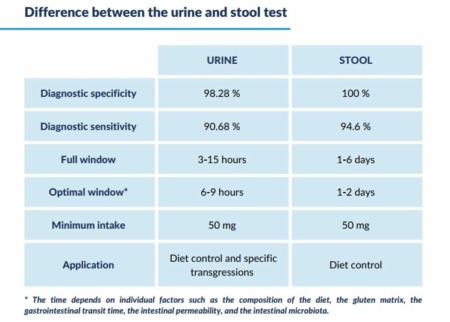Q: What is the difference between the urine and stool tests?

Q: Do I need a doctor to order or prescribe Gluten Detect for me?
A: Gluten Detect is available for purchase online without any recommendation, and will be shipped directly to your home.
Q: I‘m sure I don’t eat gluten because I don’t have any symptoms - why should I use this test?
This is one of the most common misunderstandings we come across. Recent clinical studies show that
more than 70% of coeliac patients who do not have symptoms present with atrophy (damage)
of the intestinal mucosa. Although many patients’ base the extent of their compliance with their diet on the
absence of symptoms, they may still be ingesting gluten without knowing it. These
small intakes are only detectable through gluten fragments excreted in stool and urine.
It is important to be clear that a minimum amount of gluten always causes intestinal damage to a celiacs
body, regardless of whether or not it results in symptoms. Gluten Detect checks for this silent consumption of gluten and helps you locate where it may be coming from so you can make adjustments with your diet.
Q: What effect do unnoticed gluten intakes have on my small intestine?
The damage caused by small, regular intakes of gluten is cumulative and over the long
term prevents your intestinal mucosa from recovering. This damage causes the intestinal villi to lose their
ability to absorb nutrients and increases the probability of future more serious diseases such as lymphomas, autoimmune diseases and bone weakness.
Q: Can I order the test through a lab instead of doing it at home?
A: Presently the test is only available in the rapid, at-home version (Gluten Detect), but may be available in the future as a lab-based, send-in test.
Q: Where can I buy Gluten Detect?
A: Gluten Detect is currently only available for purchase in the US and Canada online at glutendetect.us
Q: How long will it take my order to arrive?
All USA orders will ship via USPS service, taking 2-5 business days for delivery.
All Canada orders will ship via UPS, taking as long as 7 business days for delivery
Q: How should I store the kits?
A: Kits should be stored at room temperature at all times, so storage in a bathroom drawer or cabinet is ideal. Excessive heat or cold should be avoided, especially for extended periods of time.
Q: What are Gluten Immunogenic Peptides (GIP) ?
A: Gluten Immunogenic Peptides (GIP) are fragments of gluten proteins that are resistant to gastrointestinal digestion. GIPs are found in anyone who ingests gluten but they trigger immunologic reactions in celiac patients.
Q: Should I Use the Stool or Urine test?.
A: Gluten is excreted into urine quickly, whereas it persists in the intestine for days. Urine therefore is most appropriate for determining acute contamination during the previous 15 hours, whereas stool is most appropriate for monitoring compliance over a longer period of time (previous 1-6 days). Each test covers different periods of time and so both tests together will provide the most complete answer to whether you have ingested gluten recently.
Q: The red test line on my test is barely visible. Is that still a positive result?
A: Yes, any visible red line in the test zone is a positive result, even if weak. If uncertain, conduct a second test to verify. If you used the urine test, check the next day with the stool test for greater sensitivity.
Q: I got a positive result. Now what?
A: See the following web page here for suggestions on dealing with a suspected source of
gluten.
Q: Is there something wrong with the performance of my test?
A: As long as the ‘Control’ line appears on the test, the test has functioned properly. If the control line does not appear, contact customer service immediately to report the failure, and have the lot number on the bottom of the box kit ready to report to our agents.
Q: How accurate is the Gluten Detect test?
A: The molecule on which the test is based is proven to be >96% specific for gluten fragments and each tests is 90-95+% reliable within their respective time windows and limits of detection (i.e. 2 bites of bread in past day for urine test OR crumb of bread over previous days for stool test).
Q: Is Gluten Detect FDA approved?
A: Gluten Detect has not been evaluated by the FDA although the test has been clinically validated and the technology has been published in top scientific, peer-reviewed journals.
Q: Should I ask my dietitian or other professional about Gluten Detect or share my results with her/him?
A: We are working relentlessly to educate everyone about Gluten Detect, especially dietitians. If they are not aware of Gluten Detect, encourage them to visit our website to learn more. Your results are scientifically sound, so you can be confident when sharing them with anyone.
Q: How often do you recommend using Gluten Detect?
According to recent clinical studies, when three urine samples are measured throughout the week and the result is negative, there is more than a 97% chance that there has not been a recent gluten ingestion and that your intestine is in good condition. Similarly, two negative stool tests over a week would indicate good compliance with the gluten free diet.
Based on these clinical studies, we recommend that you measure 3 urine samples over the course of a week (first morning urine is best) with one of them during the weekend. Alternatively you could test 2 stool samples, 3 to 4 days apart.
The tests should be used regularly to monitor compliance with the gluten free diet over time.
Q: I’m on a gluten free diet already - what are my chances of having ingested gluten?
According to several recent clinical studies gluten intake, involuntary gluten intake does happen regularly among celiac patients on gluten free diet. These studies estimate that almost 90% of celiacs may involuntarily ingest gluten each month.
Following a gluten free diet all the time is very difficult, especially when traveling or eating away from home at restaurants and studies show that most involuntary gluten intake happens during weekends when there is a higher risk of exposure.
Q: Can I get a positive result in urine but not in stool or vice versa?
Yes its possible to see a positive result in one type of test but not in the other because the dynamics of excretion are so different between urine and stool and is very dependent on sample timing. That’s why we recommend using both test forms to be sure of compliance.
Q: Can a person who has consumed gluten still get a negative result?
Although unlikely, this is possible since the detection of GIPs depends on the excretion dynamics for each individual. For this reason its important to test at multiple time points as recommended above.
Q: What is the Gluten Detect return and refund policy?
Gluten Detect has a 7 day, no questions asked return policy. Please reach out to our customer service at customers@glutendetect.us. Refunds will be issued within 48 hours of your customer service response. However, it may take longer to show on your bank account depending on their terms.
Q: What countries outside the United States do you ship to and what are the costs of importing Gluten Detect?
In addition to orders from customers located in the United States, Glutenostics also ships to customers in Canada, Mexico, and Australia. Shipping costs to countries outside the United States do not include local duties and taxes that are collected by individual countries on imported goods. These duties and taxes are the responsibility of non-U.S. customers for each purchase.
